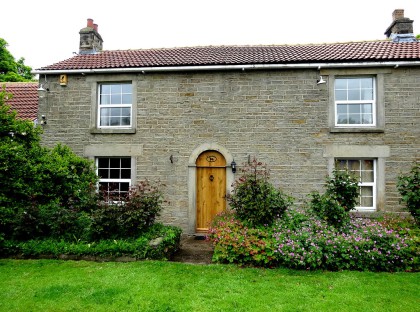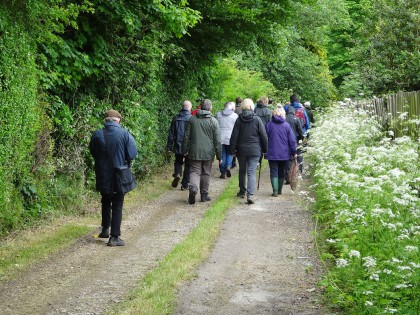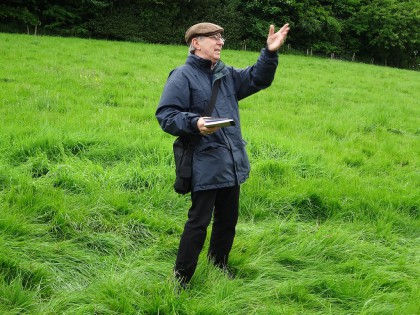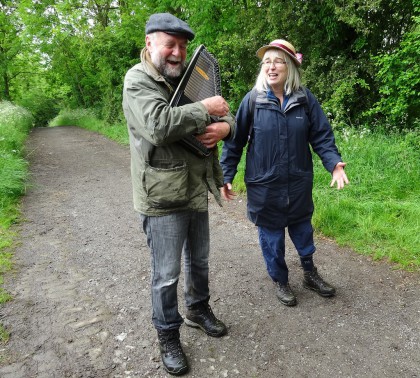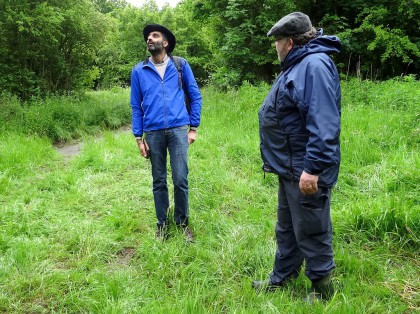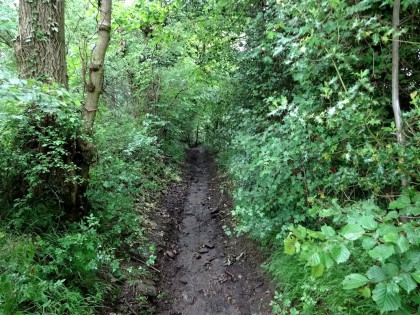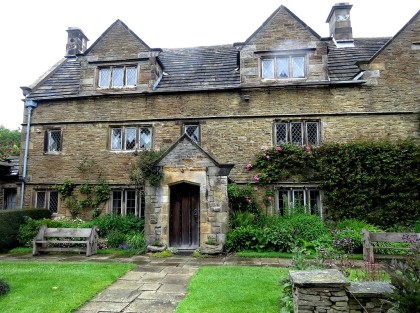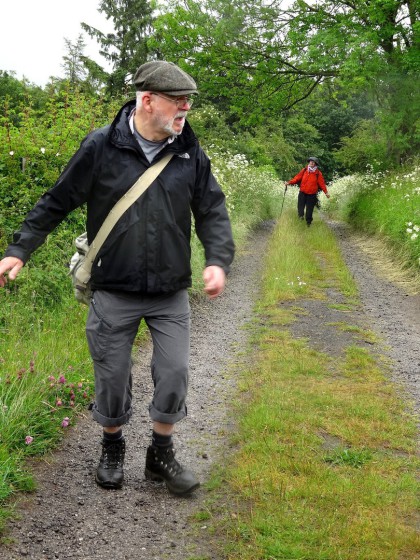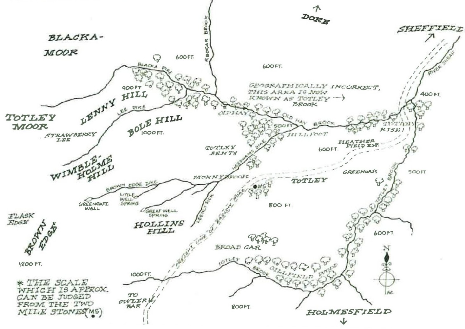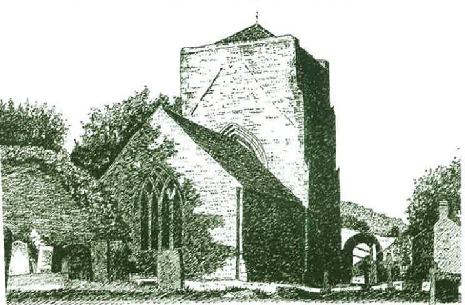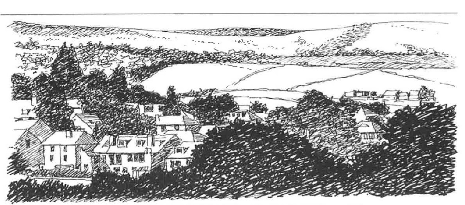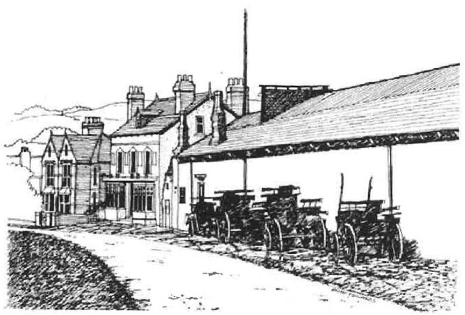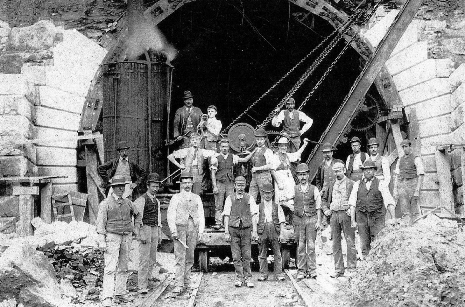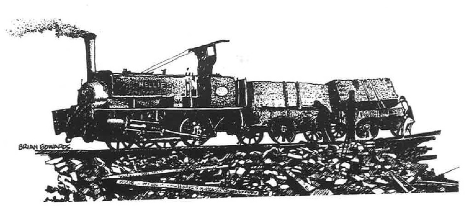Ruskin in Totley
Ruskin, Totley and St. George's Farm
by Dr. Mark Frost and Sally Goldsmith
Boots, Fresh Air & Ginger Beer
Throughout this year a series of events is taking place celebrating 'Ruskin in Sheffield'. The Ruskin in question being John Ruskin the celebrated Victorian art critic and philanthropist. Over the weekend of 13 and 14 June there have been three performance walks around Totley where, in 1877, Ruskin bought St George's Farm which was to be worked communally by a group of working men and their families from the heavily industrialized city of Sheffield.
The performance, which was written by Sally Goldsmith, also included other well known local characters who were connected with Totley and the surrounding area between 1877 and the early 1950s. The final walk took place on a rather wet and dismal Sunday afternoon. The photo above is St George's Farm as it is today, we were privileged to see it as it isn't visible from the road and the current owners value their privacy. The earliest record that Alan, the current owner, has found is for 1802 but it may be older than that. Alan also said that originally there were three dwellings here, the main farmhouse and two labourer's cottages. It should be said that the experiment with farming was not a howling success and the experiment came to an end in 1885. This is just a record of the walk and one or two of the characters we met on the way round. There are other articles on our website which will tell you more about both John Ruskin and the experiment with farming.
Off we go - about twenty of us were in the group. None of the 'characters' were in costume. When we mention a name it is that of the 'character' not the person playing him/her.
Here we have Harry Brearley the inventor of stainless steel. He was born into a poor working class family in Sheffield and started working as a labourer in a steel mill when he was 12 years old. He was a very bright boy and gradually worked his way up the ladder finally becoming a director of Brown Bayley one of Sheffield's major steel companies. He married in 1895 and he and his wife came to live in a little cottage on Brook Terrace, a little lower down and on the opposite side of road to St George's Farm. Sadly Brook Terrace is now long gone. Again there is an article on the website written by Bill Glossop whose aunt was Harry Brearley's secretary.
Joseph Sharp and Mrs Malloy who are two of the people who were involved in the St George's Farm experiment. Joseph Sharp was a musician, originally from Nottinghamshire, who earned his living by playing the harp in pubs and at social functions.
On the left is Edward Carpenter who is a very interesting man and by all accounts a very likeable one too. He was born in Sussex into a wealthy family and was a Cambridge graduate. He became a socialist poet and philosopher and was also an early gay rights activist. He lived for a while in Totley before moving to nearby Millthorpe where he had a small market garden. On the right is William Harrison Riley who was another of those involved with St George's Farm. He later went to live in America and became a friend of the poet Walt Whitman.
This is part of the old holloway which goes back to medieval times and very probably earlier than that. It was once part of an important route from the South into Sheffield. This is what it looks like after a couple of days of rain. You can imagine what it was like during the winter. In some places along the route you can still see the old cobbled track.
This is Woodthorpe Hall where we stopped for a drink and another little performance. The house inside is just as lovely and atmospheric as it is outside. The Shepley Family have lived there since the 1920s .
The last two characters - Bert Ward and Ethel Haythornthwaite. G.H.B.Ward founded the Clarion Ramblers Club in 1900 and they were the chief organization campaigning for public access to the moorland areas of the Dark Peak. The Clarion Ramblers were the first working class ramblers club in the country. Bert was a real activist for walker's rights and also wrote the Clarion Rambler's annual handbook all of which are full of interesting local history as well as giving the routes of their weekly Sunday walks most of which covered about 18 miles! The walks had to be on Sundays of course as the working week in those days included Saturdays. The Clarion Ramblers handbooks are very collectable now and the early ones can cost over £30 which is a lot for a tiny book measuring about 4x3 inches. Though born in Sheffield, in the later part of his life Bert Ward lived locally on Moorwood Lane.
Ethel Haythornthwaite founded the Sheffield Association for the Protection of Local Scenery in 1924 which in 1927 became the Sheffield and Peak District Committee of CPRE, the Council for the Preservation of Rural England, now restyled Campaign to Protect Rural England. She and her husband saved areas such as Edale, Mam Tor and Blackamoor from development and were instrumental in establishing the Peak District as the UK's first National Park in 1951.
In spite of the weather the whole walk was great fun. The title Boots, Fresh Air & Ginger Beer - boots for Bert Ward and the Clarion Ramblers, fresh air for all the outdoor activities and ginger beer, a jolly good drink to take on a picnic.
Thanks to www.circleoftheyear.blogspot.com
‘Derbyshire is a lovely child’s alphabet’: Ruskin, Railways, St. George's Farm and Totley's Heritage
by Andrew Russell
There seem to be two important dates in Totley's history which are relevant to this article. The first is May 1842, when the Totley Enclosure Act was passed, giving away Totley's common land to a few wealthy and distinguished landowners. The landowners' rights became 'almost absolute' and 'people's rights [were] effectively, nonexistent' [1]
The second date is 1935, when Totley, Dore and Greenhill were taken in by the City of Sheffield, away from the county of Derbyshire. The long development of the railways took place between these two dates, specifically the outward growth of the railway from Sheffield to Totley in the early to mid-1870s, and then into Derbyshire and beyond to Manchester in the 1880s and 1890s. This was a period when many rural communities were joined to towns and cities. Sheffield expanded to Totley. Links between towns, cities, villages and counties all over the country would change forever.
The Saxon origin of the name Totley indicates the settlement of 'Tot' or 'Toft' on the hill amidst the open clearings. As a 'look -out' it provides glorious views extending for miles. [2] Totley
includes land situated from about 400 feet below Totley Rise, climbing to 1300 feet at Flask Edge on its far south-western border. It grew to cover an area of some three and a half miles by two
miles, by the nineteenth century. It is an area of fast-flowing streams, abundant in wood—and with the local gritstone, Totley had all the raw materials necessary for the grinding-wheels in the
watermills were dotted along the local streams and tributaries that ran into the River Sheaf at Totley Brook, and on to Sheaf-field, or Sheffield, some six miles away. From medieval times, lead
smelting and rolling, paper-making, corn-grinding and scythe-making were prominent at various stages, although much of the workforce remained engaged in agriculture.
Over the centuries, Totley had consisted largely of a succession of farms and farming communities. In the medieval period, Totley's land was close to Beauchief Abbey in the parish of Ecclesall—an abbey in a dale. The Abbey was founded by Robert FitzRanulf in 1183 and had mills on the River Sheaf. The monks residing there farmed sheep, for fleece and mutton. By the 12th century they had a sheep grange at Streberry-ley (Strawberry Lee) in Totley Bents. Whilst the Abbey is still partially standing, and the old ponds which supplied the monks with their carp remain, [3] the original pasture of their sheep grange can only be traced through old documents.
Brian Edwards traced out a route through Totley by which the monks would have taken their flocks of sheep over the course of the year, a journey made for almost three hundred years until the Dissolution of the Monasteries. This rich medieval history would have been looked on approvingly by Ruskin, and he might have felt that 'in the main temper of its inhabitants, old English, and capable, therefore, yet of ideas of honesty and piety by which Old England lived.' [4]
Ruskin outlined a bucolic vision in the first number of Fors in 1871 that suited rural Totley well:
We will try to take some small piece of English ground, beautiful, peaceful and fruitful. We will have no steam trains upon it and no railroads; we will have no untended or unthoughtful creatures upon it; none wretched, but the sick; none idle, but the dead .. , [5]
This is the spirit in which Ruskin approached the creation of St. George's Farm in Totley where:
A few of the Sheffield working men who admit the possibility of the St. George's notions being just, have asked the to let them rent some ground from the Company, whereupon to spend the spare hours
they have, of morning or evening, in some useful labour. [6]
The communal farm at Totley was started by a group of men shortlisted by Henry Swan, the Curator of the Guild of St. George Museum in Walkley, Sheffield. Edward Carpenter, socialist, poet, philosopher, and early gay activist, was influenced by and wrote to Ruskin, describing them:
A small body—about a dozen—of men calling themselves Communists, mostly great talkers, had joined together with the idea of establishing themselves on land somewhere; and it was at their insistence that John Ruskin bought a small farm (of thirteen acres or so) at Totley near Sheffield, which he afterwards made over to St. George's Guild.
Carpenter followed the fortunes of St. George's Farm and lived close by in Bradway, and on inheriting money from his father, he established himself at Millthorpe, near Barlow, Derbyshire for a simpler life closer to nature, a life of market gardening and rural craft. The period from 1877 onwards marks a chequered history for St. George's Farm, as so well outlined in Frost's new book, The Lost Companions. [7] When John Ruskin visited his new venture some two years later, on 17th October 1879, all seemed—at least on the surface—to be going well. Ruskin cheerfully described his 'faithful old Gardener' David Downs, as resident 'for a while at least, at Abbeydale' [8] to look after the communal agricultural project with Riley 'in feathers' and 'especially proud of some rows of cabbages'. Ruskin tells us that he 'had tea in state at Totley and looked at all the crops.' [9] Yet, as Frost points out, 'relations remained cordially guarded.' [10] In fact, after his visit, Ruskin decided to remove Riley from St. George's Farm and leave the management to Downs. This marked a phase where the Totley 'experiment' went through a difficult period.
Yet, on that day's visit, Ruskin must have seen around him the beautiful Derbyshire countryside, which is reflected in a line in a letter he wrote to the Manchester City News in 1884: 'Derbyshire is a lovely child’s alphabet; an alluring first lesson in all that’s admirable and powerful, chiefly in the way it engages and fixes the attention,' [11].
William Harrison Riley had come to Sheffield in 1877. He edited The Socialist from June to December of that year, sending a copy to Ruskin, who, with some guarded comment and criticism, thought there was a great deal of good in it. Riley took centre-stage in the St. George’s Farm community for a period in 1878. Like Carpenter, he was an admirer of the American poet Walt Whitman, and looked for a communal agrarian life. It was a project nourished 'by a vague but persisting recollection of a past Golden Age ... a Garden of Eden separated in time and space from the realities of common life.' [12] Totley fitted this description, in that it had been long protected by the green band of Whirlow, Ecclesall Woods, Ladyspring Wood and Beauchief Hall—hidden and remote from Sheffield’s industrial sprawl.
Yet in the late 19th century, change was accelerating everywhere and one of the main agents in this, as I started out by saying, was the growth of the railways. Prior to the Sheffield railway line
reaching Dore and its immediate neighbour, Totley, there was just one horse-drawn bus per day which travelled out from Sheffield covering the six or so miles to this area. This must have entailed a
long and often difficult journey; especially in the autumn and winter. With the opening of the railway station in 1872, there were trains carrying far more people out to Dore and Totley and with
greater frequency, at speed and with protection from the weather. Land prices rose as a result, and even before the arrival of the railway, plans for suburban villas were being drawn. Sheffield men
were coming to the rural village of Totley. Symbolically, with the building of Dore and Totley station, the site of the medieval Walk Mill—which the monks of Beauchief Abbey had worked, frilling
(cleansing) their cloth—was demolished, and the dam that powered the mill was filled in. A few years later, Ruskin, apparently looking back to the monks at Beauchief Abbey, described his St. George
Farm workers as 'in the spirit of monks gathered for missionary service.' [13] He always preferred to call the Totley farm 'Abbeydale' providing a link back to the Abbey at Beauchief.
Already in the summer of 1873, the Totley Brook Estate Company, made up of a brush manufacturer, a County Court Clerk, a timber merchant and two building contractors—Sheffielders all—was planning new
housing. As Brian Edwards rightly points out, 'The railway was the turning point in the development of the [Totley] district.' [14] The railway ushered in an era of building that gained momentum in
the decades that followed.
St. George’s Farm, led first by Edwin Priest and later by Riley, hosted fellow travellers during 1878, who were dropping in to lend a hand, discuss politics and poetry and crack intellectual jokes.
Many visitors went to the farm, and newspaper correspondents had things to say about us, wise and otherwise. Now our expenses were increased and we had to meet them, so we had parties to visit during
the summer taking tea, for which they were charged. ... Every Wednesday, we went to Dore and Totley [station] from Sheffield, bringing back fruit, eggs, and vegetables to the meetings which the
members purchased. [15]
The Totley Brook villa estate started in 1873, later failed as the land and its planned housing was bisected by the incoming railway as it reached Totley. Another very grand enterprise, though
short-lived, took shape in the mid-1880s, initially rooted entirely in land speculation. Alderman Joseph Mountain, one of Sheffield's building magnates, planned a pleasure garden that would rival the
Belle Vue Gardens in Manchester. Many used the railway to go to the opening of Victoria Gardens which lay on a piece of land bordered by Baslow Road, Mickley Lane and Totley Brook. Opened on Whit
Monday, 1883, the ceremony attracted 10,000 people who enjoyed a variety of theatrical entertainments; there was a ballroom, and refreshments were served (the restaurant roof and walls were mostly
made of glass) and there was a 400-yard promenade with extensive views over the Derbyshire Moors. The grounds were later laid out for cricket, tennis, bowls and archery, and later still for cycle
racing. [16] Local landowners were not happy with this large development. A drinks licence was refused, and in 1886, Mountain was summoned on grounds of a breach of the Public Health Act, for
permitting raw sewage from one of his Totley Rise properties to drain into a local landowner's lake. By 1887, the venture was failing. When Joseph Mountain died in 1893, the Victoria Gardens were
offered for sale.
Meanwhile, David Downs, Ruskin's gardener, continued looking after St. George's Farm, which was operating at a financial loss, and when he died in 1888, the land was let to John Furniss, George Pearson and others. Furniss was a considerable figure among the Sheffield Socialists, an old-style preacher and an impressive speaker who used Totley as a base for his political activity. [17]
In the autumn of the following year, St. George's Farm was visited by G. L. Dickinson and C. R. Ashbee, two young Cambridge idealists staying at Millthorpe with Edward Carpenter. Ashbee recorded his impressions of the new commune:
There we have a community of early Christians pure and simple— some ten men and three women ... and no private property except in wives ... there was a brightness and clearness in the faces of most
of them which bespoke enthusiasm for humanity. [18]
By the end of the 1880s, the Guild of St. George offered George Pearson the farm rent-free for a couple of years, until he could afford to pay. Ironically, it was largely the building of the Totley railway tunnel to Grindleford, linking it up with the line to Manchester, that put Pearson in profit. He found a regular market among the railway navvies, and despite the smallpox outbreak in Totley at the start of the 1890s, he continued to do well, even when other tradesmen were less fortunate. So it was largely the railway that revived the fortunes of the Guild's farm, and put Pearson on the path to success. By 1935, he had seven greenhouses and a packing shed, he grew bedding plants, tomatoes and cucumbers, and had by then bought neighbouring land; the owner of 43 acres. By the time Totley became part of Sheffield and the utopian dream had faded, and before the farm had become a flourishing commercial concern, the Guild had sold the farm to him outright.
Yet for a while, at least, Ruskin's scheme had given some land back to a community of people, and had looked back to an age of Common Land which had been undermined by the Enclosure Acts. It had
given a small group of Sheffield men, who had dreamed of a communal enterprise away from the town, the opportunity to experiment. These people had political ideas that were new, though, in part,
rooted in the Chartist movement. The Totley Farm shows how fraught with difficulties such a communal project was. Ruskin—in choosing the rural and remote Derbyshire village of Totley, at a time when
the railway he abhorred was rapidly opening the area up to speculation, change and enterprise— became an important part of the local history before Totley left Derbyshire and became a suburb of an
industrial city in South Yorkshire.
This article is in part a tribute to Brian Edwards, who died in February of this year on his 78th birthday. Illustrations from his publications, Brian Edwards' Drawings of Historic Totley (1979), Totley and the Tunnel (1988) and Dore, Totley and Beyond (1993) have been reproduced with the kind permission of his widow, Pamela Edwards.
Brian was a creative and intuitive researcher, and an accomplished artist and designer. He lived in Totley for many years, recording its history, buildings and natural features at a time when the
area was beginning to change rapidly. His rich archive of notes and drawings has ben digitized and is available on a USB stick to borrow.
Notes
1. Only connect: soil, soul, society: the best of Resurgence Magazine 1990-1999 (2000), p. 61 ed. John Lane and Maya Kumar Mitchell (Totnes: Green Books).
2. Brelsford, Vernon (1954) A History of Dore and Totley from the ninth to the twentieth centuries, p.3 (Chesterfield: Wilfred Edmunds).
3. Edwards, Brian (1996) Dore, Totley and Beyond: the -drawings of Brian Edwards, pp. 8-9 (Great Longstone: Brian Edwards).
4. Works 30.52, and qtd. In Walton, Mary (1949) Sheffield, its story and its achievements, p. 225. 2nd ed. (Sheffield: Sheffield Telegraph & Star Ltd).
5. Works 27.96.
6. Works 29.98.
7. Frost, Mark (2014) The Lost Companions and John Ruskin’s Guild of St. George: a revisionary history (London & New York: Anthem Press).
8. Rosenbach Museum Library 6.135.
9. Ruskin Library MS L42 2003L04889
10. Frost p. 170.
11. Works 34.571. Qtd. In Edwards, Brian (1985) Totley and the Tunnel, p.14 (Sheffield: Shape Design Shop).
12. Hardy, Dennis (1979) Alternative Communities in Nineteenth Century England, p.2 (London & New York: Longmans).
13. Price, David (2008) Sheffield Troublemakers: Rebels and Radicals in Sheffield History, p.72 (Chichester: Phillimore & Co, Ltd),
14. Edwards, Totley and the Tunnel, p.4.
15. Maloy, M., 'St George’s Farm' in Commonweal (25th May 1889), p. 165
16. http://www.totleyhistorygroup.org.uk/people-of-interest/joseph-mountain/
17. Marsh, Jan (2010) Back to the Land: the Pastoral Impulse in Victorian England 1880-1914, p. 97 (London: Faber & Faber).
18. C. R. Ashbee, entry for 4.9.1886, Memoirs (1938) vol. 1, p.31. Unpublished. Qtd. in Marsh, p. 98
Search Our Website Here
September
October
November
Unless stated otherwise our meetings are held in Totley Library on the 4th Wednesday of each month at 7.30pm.
Pauline Burnett's book The Rise of Totley Rise has been revised and updated. It tells the story of this small piece of land from 1875 when there was only a rolling mill and chemical yard alongside the river a mile from Totley, through Victorian and Edwardian times, two world wars and up to the present day. It has 94 pages including a useful index and many illustrations from private collections. The book is available now from Totley Rise Post Office priced at £5, or through our website when an additional charge will be made to cover packing and postage.
A few copies are still available of Sally Goldsmith's book Thirteen Acres: John Ruskin and the Totley Communists. Totley was the site of a utopian scheme funded by art critic and social reformer John Ruskin. In 1877 he bought 13-acre St. George’s Farm so that nine Sheffield working men and their families could work the land and, to keep themselves busy, make boots and shoes. Sally tells an engaging story from our history with a quirky cast of characters including Ruskin himself, the poet and gay rights activist Edward Carpenter and Henry Swan, a cycling, vegetarian artist and Quaker. The book is available to order online from the The Guild of St. George by following this link.
A recently discovered box of WWII correspondence reveals the story of how a small group of ladies from Dore and Totley recruited knitters from the west of Sheffield and how their efforts made them the country's greatest provider of Comforts for the Minesweeping crews of the Royal Navy. The story is told in Knit For Victory, a new book from Totley History Group. Written by Pauline Burnett, it has 82 pages and many illustrations. It is on sale in local shops and via our website. Further information about the correspondence is in this inside page of our website: Dore & Totley Minesweeping Trawlers Comforts Fund.
The story is told in Totley War Memorial WW1 of the ten men from our village who gave their lives in the Great War. Written by Pauline Burnett, Jim Martin and Dorothy Prosser, a chapter is devoted to each of the soldiers with a family tree followed by as much information as could be discovered about the men and their families. There is also information about their military careers and the actions in which they lost their lives. The book has 64 pages and is illustrated throughout with photographs of the men, their families and the houses where they lived.
Totley All Saints' Church Parish Magazines for the years 1985-2006 with notices of baptisms, marriages and funerals and accounts of spiritual, educational, charitable and social matters in the village. Scanned in full, including advertisements from local traders.
In 1893 during the building of the Totley Tunnel there was an outbreak of smallpox amongst the navvies which spread to some of the local population. 17 people were buried in communal graves in Dore Churchyard, 6 from "Green Oak" (Lemont Road). The severity of the outbreak was principally caused by overcrowding and insanitary conditions in lodging houses .
Kathleen Grayson was a 39 year old housewife when WW2 broke out. She volunteered for the ARP and became an ambulance driver. During an air raid on Sheffield in July 1941, and despite her own injuries, she managed to get a seriously injured casualty to hospital. For this she was awarded a commendation from King George VI. Together with her friend Hilda Duffy, Kathleen also assembled a team of knitters to provide essential warm clothing for the men serving on the minesweepers patrolling the North Sea.
We have recently bought at auction the WW2 memorabilia of Douglas Platts whose family home was at Hillside, 98 Queen Victoria Road. After the war Douglas returned to his civilian occupation working in the family scissors manufacturing business. He lived in our area for the rest of his life.
We are very grateful to Mrs Valerie Taylor of Dore for lending us the title deeds to Lower Bents Farmhouse which is reputed to be the oldest surviving building in the area with a proven history back to 1621. We have now scanned and transcribed the deeds which could be particularly interesting to anyone with a connection to the local Fisher, Dalton and Marshall Families.
Until 1844, when Dore Christ Church parish was created, Totley township was part of Dronfield parish. We have now transcribed the burial records for former Totley residents at St. John the Baptist, Dronfield for the period 1678-1870 and at St. Swithin, Holmesfield for the period 1766-1901.
Whilst researching the history of the Dalton Family we found it useful to transcribe a number of early Wills and Inventories. These and those of many other Totley, Dore and Holmesfield people dating from between 1594 and 1856 have now been added to our website.
St. Swithin's Church, Holmesfield pre-dates Dore Christ Church and was the place where many of the people from Totley worshipped and were baptised, married and buried. Read the inscriptions on more than 750 gravestones in the churchyard including those of Mr. and Mrs. William Aldam Milner of Totley Hall, Jessie Matilda Tyzack (nee Fisher) of Avenue Farm, and Rev. J. A. Kerfoot of St. John's, Abbeydale.
Thomas Youdan was a music hall proprietor and benefactor who was living at Grove House, Totley in 1867 when he sponsored the first football knockout competition in the world for The Youdan Cup.
The words Millhouses Cricket Club can be seen in the background of team photos which are likely to date from between 1905 and the early 1920s, very probably pre-war. They were lent to us by Garth Inman who can identify his great uncle, Cecil Inman, in some of the photos and would like to know when they were taken and, if possible, the names of others present. Please take a look to see whether you can put names to any of the faces.
Josiah Hibberd was seriously injured whilst working on the construction of the Totley Tunnel in 1892. He died on 9 May 1897 at the age of 38 having apparently spent most of previous five years in hospital.
Bradway House was built around 1832 by Henry Greaves, a farmer, together with two adjacent cottages. We have traced most of the occupants of the property from these early days up to the start of World War Two.
We have transcribed the baptisms records at St. John the Evangelist, Abbeydale from when the church was consecrated in 1876 until just after the start of World War 1. The records are arranged in alphabetical order based upon the child's name and show the date of baptism, the names of the parents, their home location and occupation.
Nick Kuhn bought an original 1920s poster which had this owners' blind stamp in one corner. The stamp almost certainly refers to a house named Wigmore that was built in the late 1920s or early 1930s. The first occupiers that we can trace are John Howarth Caine, a district mineral agent for the LNER, his wife Florence Jane (nee Prince) and daughter Doris Mary. The Caine family lived at Wigmore until 1936 by which time the house would have been known simply as 12 The Quandrant.
George Griffiths died on 13 December 1888 following an explosion during the sinking of number 3 airshaft at Totley Bents. His widow Florence died shortly afterwards and his two daughters Maud and Annie were adopted separately. Whilst Annie lived the rest of her life in Yorkshire, Maud emigrated to Australia in 1923 with her husband, John Burrows, daughter Margaret and son Jack, pictured above.
George Wainwright was said to have been born in Bamford, Derbyshire in 1714. He learned the trade of linen weaving and moved to Totley after his marriage on 1744. He became an ardent follower of John Wesley who paid many visits to Sheffield and who would have passed through or close to Totley. Preaching was at first conducted out of doors and when Wesley's preachers became harassed by a mob of Totley ruffians in 1760, George offered them safety of his own home. He remained a Methodist for all of his long life, dying in Dore in 1821 at the reputed age of 107.
Oakwood School was started by Mrs Phoebe Holroyd in 1925 initially as the Firth Park Kindergarten and, by 1927, as the Firth Park Preparatory School. Phoebe was still working at the school almost fifty years later when she was well into her seventies. We would like to hear from anyone with memories of the school.
James Curtis was born at sea aboard HMS Chichester in 1790. He enlisted as a Private in the 1st Grenadier Regiment of Foot Guards in Sheffield in 1812 and served in Spain and Portugal during the Peninsular War. He later fought in France and Belgium taking part in the Battle of Waterloo. In later life James lived at the Cricket Inn where his son-in-law William Anthony was the licensed victualler. He died in Heeley in 1882 aged about 91.
Charles Paul lived in Totley in later life. He was a local historian and archaeologist who was an authority on the history of Sheffield, especially the two areas he knew best: Attercliffe and Ecclesall. His books and letters to local newspapers were published under the Latin form of his name Carolus Paulus.
Towards the end of the 19th century Totley Hall gardens became a well known beauty spot that attracted many hundreds of visitors from Sheffield on open days and the rock gardens became one of its most popular features. Mrs Annie Charlesworth sent us six glass transparencies of the rock gardens taken, we believe, in the early years following the Great War.
Anton Rodgers send us photographs of three water-colours that had been bought by his grandfather at a sale of the contents of Abbeydale Hall in 1919. One was of a scene said to be in York by A. Wilson. A second was of a seated child with a dog believed to be pianted by Juliana Russell (1841-1898). The third was of Lake Como, by Ainslie Hodson Bean (1851-1918) who lived for much of his life on the Riviera and in North Italy.
A Canadian correspondent sent us photographs of a set of silver spoons that were bought in a small town in British Columbia. The case contained a note signed by Ebenezer Hall indicating that they were a wedding gift to Maurice and Fanny Housley. We think we may have traced how they got to Canada and where they might have been since.
Green Oak Park was opened on 23 March 1929 on land that had been bought by Norton District Council from John Thomas Carr, a farmer and smallholder of Mona Villas. In later years, the buildings were used by the Bowling Club (the green having been built in 1956) and by the park keeper. However, the buildings appear to have been constructed in several phases, the oldest of which predates the park to the time when the land was used for pasture.
We believe the old Totley Police Station at 331 Baslow Road was built around 1882. Two lock-up cells were excavated just below floor level in the summer of 1890. We have traced the Derbyshire Constabulary police officers who lived there from John Burford in 1886 to George Thomas Wood who was there when Totley was absorbed into Sheffield in 1934.
David Stanley lived in Totley Rise in the later years of his life. Born in Bulwell, Nottinghamshire, he joined the 17th Lancers when he was 19 and rode in the Charge of The Light Brigade at the Battle of Balaclava where he was seriously wounded. For the first reunion of veterans in 1875, he told his story to a reporter from the Buxton Herald.
This picture postcard was addressed to Miss Abell, Holly Dene, Totley Brook Road and posted in Rotherham on 10 December 1907. Edith Annie Abell was born on 4 February 1887 in Sheffield and her family came to live in our area in the 1900s, staying for the rest of their lives.
Charles Herbert Nunn enlisted in the British Army on 23 August 1915 and was sent to France on 18 December 1915 to served with the British Expeditionary Force. In March 1916 it was discovered that he was underage and he was returned home. Shortly after his 18th birthday he re-enlisted and was again posted abroad where, in addition to this trio of medals, he was awarded the Military Medal.
This certificate was awarded jointly by the Red Cross and St. John's Ambulance to Isaac Henry Williams, of Lemont Road, for his services during WW1 as a stretcher bearer. We are seeking anyone who can help us pass it on to a living relative.
In 1832 Samuel Dean pleaded guilty to stealing a quantity of lead from the Totley Rolling Mill and was sentenced to seven years transportation to Australia. He sailed on the Mangles and upon arrival in New South Wales he was sent to work for William Cox, the famous English explorer and pioneer. After receiving his Certificate of Freedom in 1840, Samuel became a farmer and went on to have a very large family. Samuel was born in Whitechapel around 1811 to parents Samuel Dean Snr. and Susannah Duck. His descendant Sarah Dean would like help in tracing his ancestry.
Ellen Topham was born in 1889 in Nottingham. Her parents had been living together since 1862 but had never married so it was most unusual that, after their deaths, Ellen was accepted into Cherrytree Orphanage. Even more so since her father, Snowden Topham, had been acquitted somewhat unexpectedly in a widely reported manslaughter trial. Ellen remained at Cherrytree until her death from pulmonary tuberculosis at the age of 15.
Mabel Wilkes was a resident in Cherrytree Orphanage between 1897 and 1905. Her granddaughter Sally Knights sent us these images of a book presented to Mabel as a prize for her writing. Sally also sent us some personal memories of her grandmother and a photograph of a locket which contains portraits of Mabel and her husband Septimus Gale.
John Henry Manby Keighley was living at Avenue Farm when he enlisted in 1916. He fought in France with the Cheshire Regiment but after home leave in early 1918 he went missing. The Army were unable to determine whether he had deserted or returned to the front and been either killed or captured by the enemy. In August 1919 he was formally presumed killed in action but it appears he did not die but returned home to his family.
Horace Ford was admitted to Cherrytree Orphanage on 26 October 1888 at the age of six. He left at the age of 14 to become an apprentice blacksmith and farrier. Soon after his 18th birthday Horace enlisted in the Imperial Yeomanry to serve his country in the war in South Africa. His letter home to his Orphanage mentor tells of the lucky escape he had in battle.
Pat Skidmore (née Sampy) lived on Totley Brook Road from 1932 to 1948 before her family moved to Main Avenue. In this short article she remembers her time at Totley All Saints School where she was a contemporary of Eric Renshaw and Bob Carr.
As we have nowhere to exhibit memorabilia and artifacts, we have created a Virtual Museum instead. The latest addition to our collection is this double-sided Totley Rise Post Office oval illuminated sign which was on the wall of 67 Baslow Road before the Post Office business transferred to number 71. Please contact us by email if you have things that you own and would like to see added to the virtual museum.
Conway Plumbe was a man of many talents who came to live in Totley Rise around 1912. As a young man he had poems published by Punch magazine and is remembered in modern collections of WW1 poetry. A number of his paintings were accepted by the Royal Academy. An engineering graduate of London University, he joined the Civil Service where he rose to a high level as a factory inspector, publishing two books on the subject and giving a series of talks on workplace health and safety on BBC radio during WW2. In retirement he wrote a philosophical-spiritual work called Release From Time.
Inside Totley Rise Methodist Church there is a Roll of Honour commemorating the soldiers from its congregation who served their king and country during the Great War. For all but one of the 28 names the soldier's regiment is recorded in the next column. The exception is David Cockshott for whom 'killed in action' is written alongside yet he appears on no war memorial in our area and no record of a mortally wounded soldier of that name is to be found. We think we have solved the mystery.
Mrs. Kate Plumbe moved from Mansfield to Totley Rise with a number of her family in 1913 and became closely involved with the Totley Union Church. Her daughter Winifred became a missionary and headmistress in Calcutta for over 38 years following which she returned home to live with her sister Hilda on Furniss Avenue. Hilda had also been a teacher, missionary and, like her mother, a volunteer at St. John's VAD during WW1.
Thomas Glossop was a cutler and razor manufacturer who was well known amongst cricketing and gardening circles. Despite going blind, he was able to continue his hobbies with remarkable success
The Totley Union Cycling Society Prize Giving and Fete was held on the fields near Abbeydale Hall on 18 July 1914. Anne Rafferty and Gordon Wainwright have named some of the people in two wonderful photographs of the event. Can you identify any more for us?
The Tyzack family are well known in our area for owning iron and steel trades at Walk Mill, Abbeydale Works, Totley Rolling Mill and Totley Forge. This article covers the history of the family from the late 18th century when William Tyzack the founder of the company was born until the early 20th century when Joshua Tyzack farmed at Avenue Farm, Dore.
Walter Waller Marrison moved to Totley around 1897 with his wife and their two young sons. He was a house builder who constructed properties around Totley Brook and Greenoak before ill health forced him to take up less physically demanding work. In 1904 he took over the tenancy of the grocers and off licence at number 71 Baslow Road. After his death in 1908, his widow Kate and later their eldest son Jack continued to run the business until it was sold in 1934.
Ron Wijk of Nieuw-Vennep in the Netherlands has sent us two scanned images of drawings of old cottages made by the celebrated Dutch painter, Anton Pieck (1895-1987) simply annotated "Totley", and wondered whether we could identify their locations.
We would like to thank Christopher Rodgers for bringing to our attention this fascinating log of the 85th Sheffield (St. John's and Totley Orphanage) Wolf Cub Pack for 1927-45. The log is published jointly by Sheffield Scout Archives and Totley History Group as a free PDF download. It is illustrated by no fewer than 92 photographs and is supported by a comprehensive index and biographies of some of the main participants.
Following our Open Meeting event on School Days, Roger Hart, Howard Adams and John Timperley have each written to us with their memories of Norwood School, which was located in the rooms attached to the Dore & Totley United Reformed Church on Totley Brook Road.
On 22nd July 1909 the children of Dore and Totley Schools celebrated by a pageant the union of England under King Ecgbert which took place at Dore in AD 827. The pageant was devised and written by Mrs Sarah Milner and her daughter Marjorie and performed in a field close to Avenue Farm in front of a large audience. Photographs of the event survive together with a fragment of the script.
John Edward Greenwood Pinder had lived all 46 years of his life in Totley but on census night, Sunday 2 April 1911, he was not at home; he was in Derby Gaol serving a sentence of three months hard labour. From the age of 20, John had been in and out of local courts for a series of minor offences including drunkenness, assault, wilful damage and night poaching. Finally he was sent to gaol for cutting down and stealing 86 small trees which he sold in Sheffield market for Christmas.
We have already transcribed the census returns for Totley, Totley Rise and Dore. Now we have transcribed Census Strays. These are people who were born in Totley but are missing from our earlier transcriptions. They may have been living, working or studying elsewhere or just away from home on the night the census was taken. Two people were in prison. Others were in Union Workhouses, hospitals and asylums. Fully indexed strays from the 1851, 1861, 1881, 1891, 1901 and 1911 censuses are available now.
We wish to thank Gillian Walker for allowing us to digitize an archive of material about the 1st Totley Scout Group. Most of the material was collected by Arthur Percival Birley in the period 1949-51 and there are many interesting documents pertaining to the building of the scout hut on Totley Hall Lane. In addition four Newsletters survive, two from the 1940s and two from 1971.
We are grateful to Angela Waite and All Saints' Parish Church for giving us access to baptismal and kindergarten birthday rolls dating from 1926 to 1941. We have transcribed the names, addresses, birthdates and baptismal dates and created an alphabetical index of entries for you to search.
Edmund Sanderson, a Sheffield estate agent, aquired the land on either side of the old drive to Totley Grove in 1874 and divided it into plots for development. He called it the Totley Brook Estate. But before many houses were built, the estate road was severed in two by the building of the Dore & Chinley Railway line. The eastern end of the road became the cul-de-sac we now call Grove Road.
John Roberts was born in Sheffield in 1798. He became a partner in one of the leading silversmiths firms in the city before moving to Abbeydale Park in 1851 and extending the house in Victorian gothic style. He paid for the building of St. John's Church and was believed to dispense more in charity than any other person in the neighbourhood including his protege Ebenezer Hall.
The Coke Family owned the Totley Hall Estate from 1791 to 1881. With the aid of a family tree to guide us, Josie Dunsmore takes us through the story of their tenure.
When the Rev. D'Ewes Coke inherited the Totley Hall Estate in 1791 it had two farms. Josie Dunsmore tells the story of how the two farms were combined under the tenancy of Peter Flint with the aid of field maps drawn by Flint himself and later by the Fairbanks family.
Do you think you recognize this face? More than sixty photographs of the girls and teachers at Hurlfield Grammar School for Girls in the 1940s were given to Totley History Group by Avril Critchley, who was herself a student at the school. The collection includes fifteen form photographs from June 1949. There would have been a number of girls from the Totley area attending the school in those days.
Christine Weaving tells the story of her 2 x great uncle George Edward Hukin, a Totley razor-grinder, and his life-long friendship with the academic, poet, writer, and free-thinker Edward Carpenter.
Eric Renshaw (pictured here on the right with Bob Carr) grew up and lived in Totley from 1932 to 1960. Many of his memories are of a sporting nature.
We are very grateful to Gordon Grayson for giving us this splendid sale document for the Norton Hall Estates, following the death in 1850 of Samuel Shore. The estates included a large part of Totley and the document has maps and illustrations, plus schedules of land and property with the names of tenants. We have also added a transcription of the entries for Totley and Dore.
Watch this Youtube video of the talk given by Dr. Mark Frost and Sally Goldsmith on Ruskin, Totley and St. George's Farm. The talk was hosted by Totley History Group on 20th May 2015 as part of the Ruskin in Sheffield programme. Also enjoy a video of the outdoor performance Boots, Fresh Air & Ginger Beer written by Sally.
When Jacqueline A. Gibbons became interested in what made her father tick, it began a journey through WW1 archive records and led to her flying from Toronto to visit the house and village where he lived and the countryside that he so much enjoyed. Jacqueline reminds us that in the early 20th century Sheffield was a driving force of industry and that Totley was the place where many of its remarkable people lived and where they formulated their ideas.
Edgar Wood was the designer of The Dingle, 172 Prospect Road, built in 1904 for Rev. William Blackshaw, the founder of the Croft House Settlement. The house, together with its western terrace and boundary walls, has now been awarded Grade II listed building status.
What was probably "the most perfect little garden railway in existence" in 1910 was to be found in the grounds of Brook House, Grove Road, the home of its designer and constructor, Guy Mitchell. Look at some wonderful photographs and read reports in newspapers and a full appreciation in Model Railways magazine.
We have now completed our transcription of Totley School's Admission Records for the period from 1877 to 1914. There is also a useful index to the names of the scholars and to their parents or guardians. We are very grateful to Sheffield Archives and Local Studies Library for allowing us to transcribe and publish these records and for permission to reproduce the photograph of a specimen page of the register.
On 8, 9 and 11 November 2014 Totley History Group held an exhibition at Dore & Totley United Reformed Church to commemorate the centenary of the First World War. Below are additional links to some of the photographs we were lent and stories we researched especially for the exhibition.
Oscar Creswick was a local farmer who served with the Army Service Corps in Salonika and who after the war returned to Totley to become the innkeeper of the Cricket Inn and a member of the village's successful tug of war team.
Walter Evans was a market gardener who also ran a small grocery shop on Hillfoot Road when war broke out. He fought with the Machine Gun Corps at the fourth battle of Ypres. After the war, Walter ran a grocers shop at the top of Main Avenue.
Fred Cartwright was another Totley soldier who survived the Great War. He fought in France and Belgium and although he wasn't wounded he was gassed and was home on sick leave when his daughter was delivered by Nurse Jessop during a snowstorm in January 1917.
Maurice Johnson joined the Yorkshire Dragoons, a territorial unit, on 1 Jan 1914 and so was called up at the very start of the war. He fought throughout the war on the Somme, at Ypres and at Cambrai. After demobilization in 1919 Maurice returned to his old occupation in the steel industry.
Bill Glossop lent us a letter written by his father, William Walton Glossop to his wife describing life in the army during training in the north east of England and asking her to keep him in mind with the children.
The photo above provides a link to an album of photographs taken of WW1 Hospitals at St. John's, Abbeydale and the Longshaw Estate.
Nora Green, of Chapel Lane, was only 14 when war broke out. In 1914 she was ill with diphtheria and was sent to the isolation hospital at Holmley Lane, Dronfield. Nora recovered and wrote a letter of thanks to one of the hospital staff and the reply she received survives.
We have collected together on this page the names of local men who appear on various War Memorials and Rolls of Honour in Totley, Dore, Abbeydale, Norton, Holmesfield and Dronfield.
Unfortunately we were unable to identify all the photographs we were lent of Totley Soldiers. Please take a look at this album to see if you recognize any of the missing names.
This walk visits locations that have strong associations with Totley during the First World War. It includes the homes of the ten soldiers from the village who lost their lives, the auxiliary hospitals, war memorials, and even the rifle range on which the soldiers trained. Take a look at the first draft of a new walk by the authors of "Totley War Memorial WW1 1914-1918"
We wish to thank the Trustees of Cherrytree for giving us permission to publish transcriptions of the Cherrytree Orphanage Admissions Book entries for the years 1866-1929. There is also an alphabetical index for you to look at.
With more people having access to faster broadband and mobile networks, we have uploaded seven full and unedited oral history recordings and also added more short excerpts for you to listen to.
Our transcriptions of local trade directories have been expanded to cover the 95 years from 1837-1932 and have also been indexed. From the days when there were a handful of farmers, stone masons, saw handle makers & scythe grinders to the wonders of the Totley Bridge Garage Company, Betty's Boudoir and The Heatherfield Shopping Centre.
We continue to add to our Totley Newspaper Archive. Recent entries have included several about The Plumbe Family, Thomas Glossop and accidents during the construction of Totley Tunnel.
Totley Church of England Parish Magazines for the years 1922-1939 and 1948-1967 with notices of births, marriages and deaths and accounts of spiritual, educational, charitable and social matters in the village.
Around 90 photographs taken by Stuart Greenhoff for his thesis A Geographical Study of Dore and Totley including several of Totley Moor Brickworks. Superb!
Chronologically ordered snippets of information recorded by Brian Edwards during his many years of research into our local history.
Read the inscriptions on more than 700 gravestones in the churchyard.
Visitors since 24 Sep 2012:


